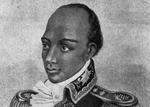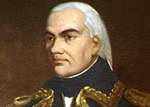Notes on
18th Century Latin American Precursors to Independence
1600 – 1810
I. The 17th and 18th Centuries:
General Considerations
Viewing Latin America from a Eurocentric and an
Anglo-American perspective (i.e., from within a course on Latin American
humanities in an American institution of higher education), it should be
recalled that from 1492 to 1607 there were no English or French (or any other)
colonies in the Americas.
This was due both to the late start that other European countries got
establishing far-flung empires and to the fact that Spain
was isolated from the rest of Europe. Spain's focus internally on the Iberian
Peninsula and in its American colonies was to protect its religious isolation
and its cultural "purity" or superiority (Spanish point of view);
that is, Spain's
unique cultural identity. Even though there were no non-Iberian (= Spanish and
Portuguese) American colonies, the English and French did have a constant
presence in the Western Hemisphere: pirates!
Pirates from France and England were a constant threat to Spanish
ships—especially the annual treasure ships that sailed through the Florida Straits—and coastal cities throughout
the Spanish and Portuguese viceroyalties. The most famous of these pirates was
Sir Francis Drake, who was a hero in England
and a criminal in Iberia and
the Americas.
He was so well known that parents throughout the Americas would discipline their
children with the verbal threat that "Drake (el Draque) would get them."
In the 18th century, the Americas were a major focus of conflicts and
wars between various European countries, most notably Spain and England. For example, in what is
called the War of Jenkins' Ear in the United
States (1739) and the War of Austrian Succession (1740-1748)
in Europe, this war was fought in the Spanish
West Indies over control of the slave trade. Seven Spanish colonies joined
forces to repulse the European invasion. (As a side note, when George
Washington's brother Lawrence Washington
returned from his unsuccessful service in the Caribbean under British Admiral Vernon, George's brother named their estate
Mt. Vernon.) During this century, England was on the offensive and Spain and its
colonies were on the defensive. The English empire was rising and the Spanish
empire was in a long, slow process of decline. English anti-Spanish propaganda
grew exponentially. Among the events the English used most in their war
propaganda were Pizarro's atrocities in Peru,
the Duke of Alba slaughtering Protestants in the Netherlands,
and Menéndez de Avilés massacring French Protestants in Matanzas Bay, Florida.
This English propaganda is known as the Black Legend. Of note in this regard is
the masterwork of Bartolomé de Las Casas, Breve
relación de la destrucción de las Indias. Interestingly and,
perhaps, understandably (from the Latin American perspective), the English
colonies in North America were not well known
in the Spanish-speaking world prior to 1776. Prior to that year, for example
none of the following American colonial works were even translated into
Spanish: John Smith's Description of New
England (1616), William Bradford's Of
Plymouth Plantation (1620-1647), and John Winthrop's Journal (1630-1649; publication, 1790). The opposite holds for
English-speaking knowledge of the Spanish-speaking world. Columbus, Cortés, Las
Casas, Acosta, Vespucci, and Bernal Díaz. As a kind of balance for the negative
view promulgated by the Black Legend, all of the great Spanish writers
(Cervantes, Lope de Vega, etc.) were very well known and liked in England, both
mother country and colonies. Furthermore, English intellectuals dreamed of
carving utopias out of the Spanish domains in the Americas. Cotton Mather, for
example, proposed the establishment of a religious utopia in Mexico where
Americans would create a "spiritual renaissance". Others dreamed of New Spain as a New Jerusalem in the Puritan tradition. It
should be noted that evangelical English-speaking Americans continued to send
many missionaries into the Spanish-speaking and Portuguese-speaking Americas in the
19th, 20th, and into the 21st centuries. As a
result Protestantism has grown significantly throughout Latin
America.
II. Conditions and Reasons for Latin American Independence Movements
The
American War of Independence (1776-1783) became the model for independence
movements throughout Spanish America and French America (Saint-Domingue / Haiti). The
idea and reality of an independent republic swept throughout the Latin American
intelligentsia. Given the centuries-long enmity between Spain and England,
Spain supported the American
patriots during the Revolutionary War by attacking the Floridas
in order to help drive the British from North America.
Even the Spanish liberals in Spain
who opposed Napoleon's invasion of Spain (1808) wrote a constitution
in 1812 modelled one Americans adopted in 1789. In 1783, one of Latin Americas
most notable precursors to independence, the Venezuelan Francisco de Miranda
(1750-1816), visited the United
States in order to study the American
political model and ideas. Just as 18th American intellectuals had
been influenced by the liberal enlightenment ideas of French thinkers such as
Montesquieu, Rousseau, Voltaire, d'Alembert, and Diderot, Latin Americans, too,
had been influenced by the ideas of the rights of man and opposition to the
notion of the divine right of kings. However, since the French Revolution of
1789 was much more violent than the American Revolution, and since Latin
American intellectuals tended to be much more conservative and more traditional
in their habits and thinking than their French counterparts, Latin Americans
looked to the United States
for a model rather than to France.
At the same
time that the Spanish wanted the British out of the Americas, so, too, of course, the
British wanted to defeat the Spanish and French empires around the world.
Therefore, the English supported Miranda and other precursors of
Spanish-American independence, and, wanting the French out of North America,
the English fought the Seven Years War (so-called in Europe, 1756-1763)—which
was known as the French and Indian War (1754-1763) in North America—thereby
defeating the French in the Canadian region of New France (la Nouvelle-France:
Québec and l'Acadie). Later, France
lost the rest of their North American colonies in New France by means of the Louisiana Purchase in 1803. The following year they lost
Saint-Domingue (the Haitian half of the Island of Hispaniola)
to the slave patriots led by Toussaint Louverture. It should be noted, however,
that America's founding
Fathers John Adams and Thomas Jefferson did not favor independence for Spanish
America because they saw the threat to the U.S. of British hegemony in the rest
of the Americas
and because the young American republicans already foresaw their own expansion
westward into French and Spanish territories. At first, Spanish Americans
harbored hope for aid from the U.S.,
but soon they were bitterly disappointed when no aid was forthcoming.
Nevertheless, after the success of the American War of Independence, Latin
Americans continued to look to the U.S. as a model and inspiration.
For example, the Great Liberator of Spanish America, Simón Bolívar () saw many
good patterns in the U.S.A.,
but he wanted to avoid blind imitation of his Anglo neighbors to the north. The
official American contact with Spanish America was made by Joel Poinsett, who
was a Jeffersonian from North
Carolina. He made a rather Quixotic odyssey to
"save" the Spanish American continent. He visited especially Buenos Aires, Argentina,
and Santiago, Chile. After his trip he advocated
American annexation of Spanish America.
Poinsett was the first American ambassador to Mexico after this country achieved
its independence in 1821, but he was forced to leave because of his aggressive
and offensive approach to Mexican officials. Poinsett spoke Spanish fluently,
and he is remembered as a keen observer of Spanish America.
He did not visit Portuguese America (Brazil). Poinsett's relations with
his Latin American counterparts is emblematic of one significant point of
friction between the two major cultural spheres in the Americas: religion.
The works
of Benjamin Franklin, Thomas Paine, Thomas Jefferson, and James Madison were
quickly translated into Spanish. Books and pamphlets concerning the United States were prohibited by Spain from
entering Spanish American, but they filtered their way in in any event. For
example, Paine's Rights of Man was translated by a Venezuelan in 1810, and the
U.S. Constitution was published in Spanish translation in Bogotá, Colombia,
in 1811. The liberal Spanish cabinet minister, the Conde de Aranda, published
his translation about Benjamin Franklin as Vida
del Dr. Benjamín Franklin sacada de documentos auténticos in 1798, and
David Ramsay's Life of George Washington (1807) was also translated quickly
into Spanish.
III. Precursors to Latin American Independence Movements
Francisco de Miranda first came to the United States with the official permission of
liberal ministers in Spain.
When Miranda spoke out for independence from Spain, he was considered an enemy
in the mother country. Many more intellectuals in the Spanish colonies sought
and were given political refuge in the United States starting in the
1790s. These political refugees went primarily to New
Orleans, Charleston, Baltimore, and Philadelphia.
Charleston had
been a safe haven for Spanish Jews (Sephardim) for over a century. Near New Orleans in 1803 Jean Lafitte (1776-1854) declared
independence from Spain on
the swampy bayou Island
of Barataria by flying the flag of Cartagena,
Colombia. This
was the first Latin American location to proclaim independence from Spain. Later
they fought heroically with Andrew Jackson in the Battle of New Orleans against
the British. Later Lafitte supported the Mexican independence movement
(1810-1821). The most important of these early centers of planning for Latin
American independence was Philadelphia
where a liberal Spaniard, Manuel Torres, acted as the key liaison between Latin
American revolutionaries and American supporters. Torres came to Philadelphia from New Granada (Colombia) in 1797. He was the most
successful of the campaigners in the United
States for Latin American independence from Spain.
A.
Tupac Amaru
(1742-1780): For a brief description about this independence precursor, click
on the following image of him:

B. Toussaint Louverture (1743-1804) : For a brief
description about this independence precursor, click on the following image of
him:
C. Francisco de Miranda (1750-1816) : For a brief description about this
independence precursor, click on the following image of him:


